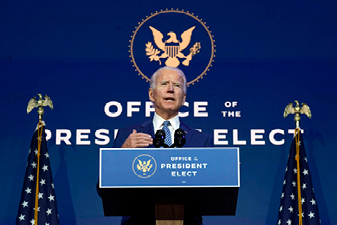|
By Cecile Entleitner, Associate, Blakey & Agnew
By now, most Americans are probably tired of hearing the words "unprecedented" and "uncertainty" to characterize this year's events. Nonetheless, they are accurate terms to describe the 2020 election. As expected, many voters across the country chose to cast their ballots early this year—either by mail or in person—which, coupled with razor-thin margins in key battleground states, stretched Election Day into Election Week. On Saturday, November 7, former Vice President Joe Biden was announced by major news outlets as the projected winner of the presidential election. While this announcement provided some clarity, several questions surrounding future administrative and legislative policy still remain, including many related to infrastructure.
Throughout the campaign, President-elect Biden discussed his economic plan to "Build Back Better," which includes the implementation of a national COVID-19 strategy and a $2 trillion investment to modernize infrastructure as a new foundation for economic growth. The plan's recovery efforts further address strengthening domestic supply chain resilience to foster job creation and ensure long-term economic stability. The platform has a strong environmental focus; establishing a set of standards and goals to reduce emissions from passenger vehicles and heavy-duty trucks as well as rail transportation. Considering the incoming president's nickname is "Amtrak Joe," the rail industry, and passenger rail advocates in particular, have high hopes for the next four years. Among other infrastructure goals, Biden hopes to spur the "second great railroad revolution" by making strategic investments utilizing existing federal grant and loan programs within the U.S. Department of Transportation. If the past few years have been any indicator, the Biden Administration will face challenges advancing its ambitious infrastructure plan. It will need broad support to tackle pivotal issues that have halted previous negotiations, including: funding mechanisms; permitting regulations; and rural vs. urban spending.
Once sworn in, Biden will likely become the first president in over 30 years to take office without party control over both chambers of Congress. Though the final composition of the U.S. Senate won't be clear until January, when both Georgia Senate seats will be decided by two runoff elections, Republicans are hoping and expecting to maintain control over the upper chamber. Meanwhile, Democrats will hold their majority within the U.S. House of Representatives. Since taking the House majority in 2018, Democrats have struggled to advance many of their legislative priorities. Such measures, including a broad five-year infrastructure proposal, have often passed the House overwhelmingly before stalling in the Republican-controlled Senate due to a lack of bipartisan support. This trend could continue into the Biden presidency as many recurring obstacles remain unresolved. On the other hand, Joe Biden may be uniquely qualified to navigate a divided Congress. During recent speeches he has strongly emphasized his commitment to unity and working with both sides of the aisle toward substantive policy changes. His
|

experience serving in the Senate alongside current Majority Leader Mitch McConnell (R-KY) and other high-ranking Senate Republicans could also offer opportunities for collaboration.
Transitions will also occur on Capitol Hill, with new key players emerging and hoping to shape transportation policy. Fostering congressional partnerships and allies will be of particular importance to the Biden Administration next year as Congress seeks to pass a surface transportation reauthorization package to replace the FAST Act, which was recently extended through September 2021. While Congressman DeFazio (D-OR) is expected to continue serving as Chair of the House Committee on Transportation and Infrastructure, the subcommittee with jurisdiction over rail policy will see a change in leadership. Reportedly, Congressman Payne (D-NJ) is seeking chairmanship over the Subcommittee on Railroads, Pipelines and Hazardous Materials, after its current Chair Congressman Lipinski (D-IL) was defeated in the primaries earlier this year.
Infrastructure policy is often touted as one of the few opportunities for bipartisan consensus. Although the two parties have differing opinions on transportation priorities and funding strategies, they generally agree that significant federal infrastructure investments are needed. If passed, bipartisan infrastructure legislation (either as part of a stimulus package or standalone bill) could represent an early win for the Biden Administration, before it delves into more controversial policy areas.
While Congress and the Administration may have difficulty agreeing on a particular approach, broad support from the general public further underscores the case for timely infrastructure investment. According to an Ipsos Global Advisor survey published in October 2020, 81 percent of Americans agree that investment in infrastructure will create new jobs and boost the economy—and 62 percent believe the government should prioritize infrastructure investment as part of its COVID-19 economic recovery efforts. But they didn't only talk the talk, American voters walked the walk…to their respective polling locations. The American Road & Transportation Builders Association reported that voters in 18 states approved a record 94 percent of state and local transportation-related ballot initiatives this year, providing an additional $14 billion in one-time and recurring revenue for transportation improvements across the country.
Blakey & Agnew, LLC is a public affairs and
communications consulting firm based in
Washington, DC.
|


